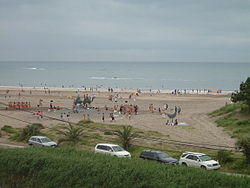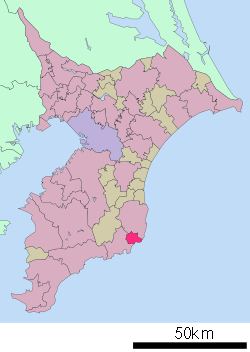- Onjuku, Chiba
-
Onjuku
御宿町— Town — Beach at Onjuku Location of Onjuku in Chiba Prefecture Coordinates: 35°11′N 140°21′E / 35.183°N 140.35°ECoordinates: 35°11′N 140°21′E / 35.183°N 140.35°E Country Japan Region Kanto Prefecture Chiba Prefecture District Isumi District Area – Total 24.92 km2 (9.6 sq mi) Population (Sept. 1, 2010 est.) – Total 7,823 – Density 314/km2 (813.3/sq mi) Time zone Japan Standard Time (UTC+9) City Symbols - Tree Oleander Phone number 0470-68-2511 Address 1522 Saga, Onjuku-machi, Chiba-ken
299-5192Website Town of Onjuku Onjuku (御宿町 Onjuku-machi) is a town located in Isumi District, Chiba, Japan. As of 2010, the town has an estimated population of 7,823 and a density of 314 persons per km². The total area is 24.92 km². The name of the town is made of two Chinese characters, the first meaning “honorable”, and the second meaning “residence”.
Contents
Geography
Onjuku is located on the east coast of southern Chiba Prefecture in approximately the center of the outer coast of the Bōsō Peninsula. The landscape consists of rolling, sandy hills of the Bōsō Hill Range, and the town is noted for its beach resorts. Its broad beaches are protected as part of the Minami Bōsō Quasi-National Park.
Onjuku is bordered by the Pacific Ocean to the east, and enjoys a temperate martime climate, with short, cool winters and hot, humid summers due to the effects of the Kuroshio Current offshore. Onjuku faces Ajiro Bay, which has two functional ports: the Port of Iwawada to the north, and the Port of Onjuku to the south. One small river, the Kiyomizu River, flows through the town to Ajiro Bay.
Surrounding municiplities
History
Early History
Onjuku is part of ancient Kazusa Province. The pines and sand of Ajiro Bay in Onjuku were referenced in a poem by Hōjō Tokiyori (1227-1263), a Kamakura-period administrator.
Edo Period
Onjuku, from the Muromachi to the Edo period, was divided into a complex mixture of administrative areas. Much of the town was tenryō territory ruled by various hatamoto on behalf of the Shogun. The town was typically associated with administrators from the Ōtaki and [[Iwatsuki Domain|Iwatsuki] domains. In the Edo period a prominent “rokusai’ichi” (六斎市) market, or open-air market held on fixed days six times a month, developed in Onjuku.
Landing of Rodrigo de Vivero
In 1609 a Spanish galleon, the San Francisco, ran aground near Onjuku. The captain and 300 survivors were cared for by the town, and later, the sailors were given a ship by the Tokugawa Shogunate to return to Mexico. One of the survivors was Governor General of the Philippines Rodrigo de Vivero, who was subsequently granted an audience with Shogun Tokugawa Ieyasu.[1]
In 1928 a tower was built in Onjuku to commemorate the landing of Rodrigo and friendly relations between Mexico, Spain, and Japan. It has since been designated an Important Prefectural Monument (県指定史跡 (ken shitei shiseki)), and is surrounded by an extensive garden complex.
Current Administration
The village of Onjuku was established on April 1, 1889, and elevated to town status on April 1, 1914. The town expanded through annexation of the neighboring villages of Fuse and Namihama on March 1, 1955.
Economy
The economy of Onjuku is dominated by summer tourism and commercial fishing; farming plays a relatively small role in the economy compared to nearby municipalities. Coast-side and off-shore fishing operations are active, with squid and bonito being the most important catches. Ama, or traditional women divers, gather abalone, turban shell (sazae), and spiny lobster, all important parts of the traditional Japanese diet.
The sandy beaches of Onjuku are the representative swimming areas of the Sotobōsō Coast and attract numerous tourists during the summer months. Tourism in the town began in the Meiji period, and development of the tourism industry continues. Numerous guests houses, ryokan (traditional Japanese inns), and hotels have developed in the area.
Transportation
Railway
- East Japan Railway Company (JR East)
Highway
Sister city relations
References
External links
- Onjuku official website in Japanese
- Chiba International Information Square in English
 Chiba Prefecture
Chiba PrefectureChiba (capital city) 
Other cities Inba District Katori District Sanbu District Chōsei District Isumi District - Ōtaki
- Onjuku
Awa District 
This Chiba Prefecture location article is a stub. You can help Wikipedia by expanding it.



